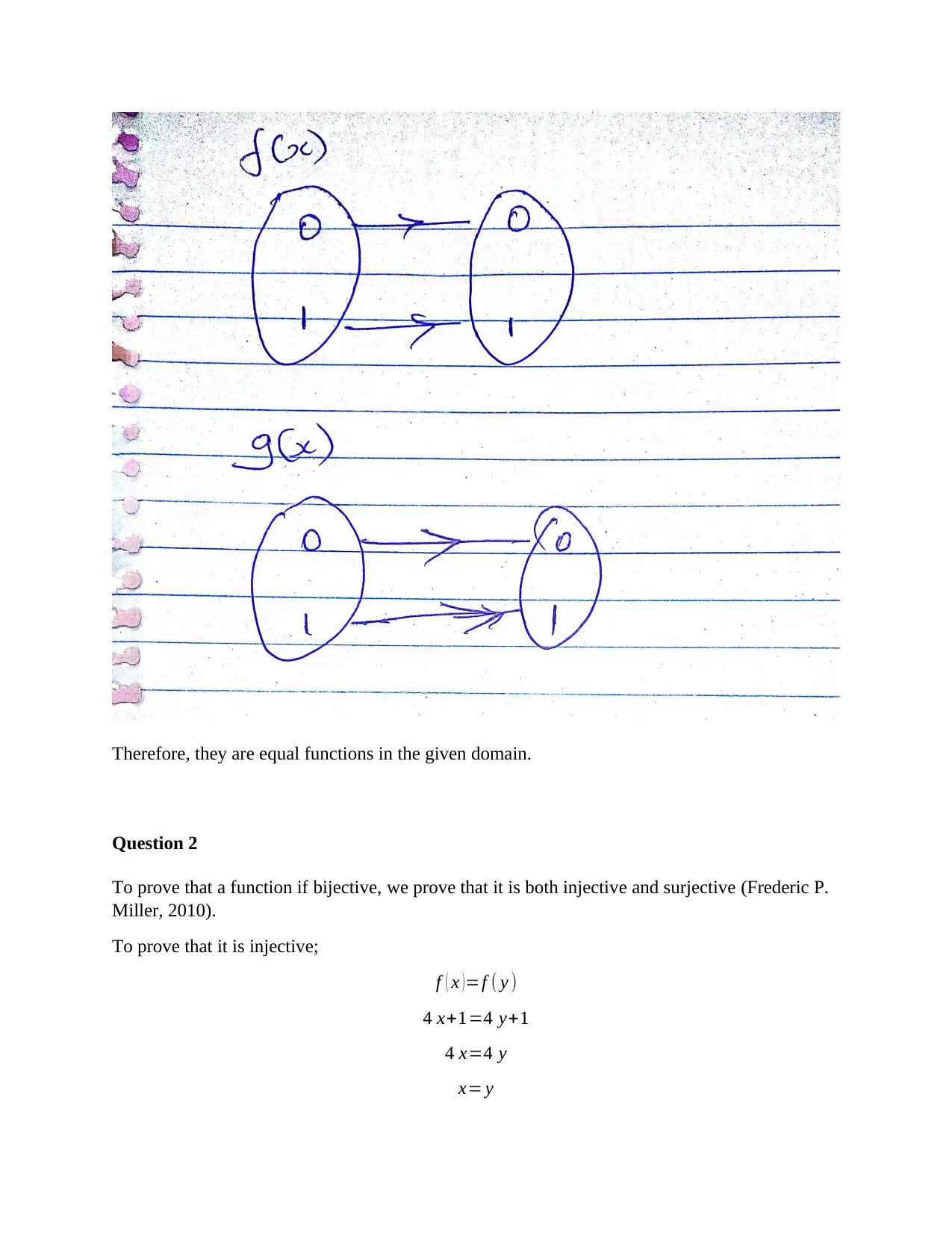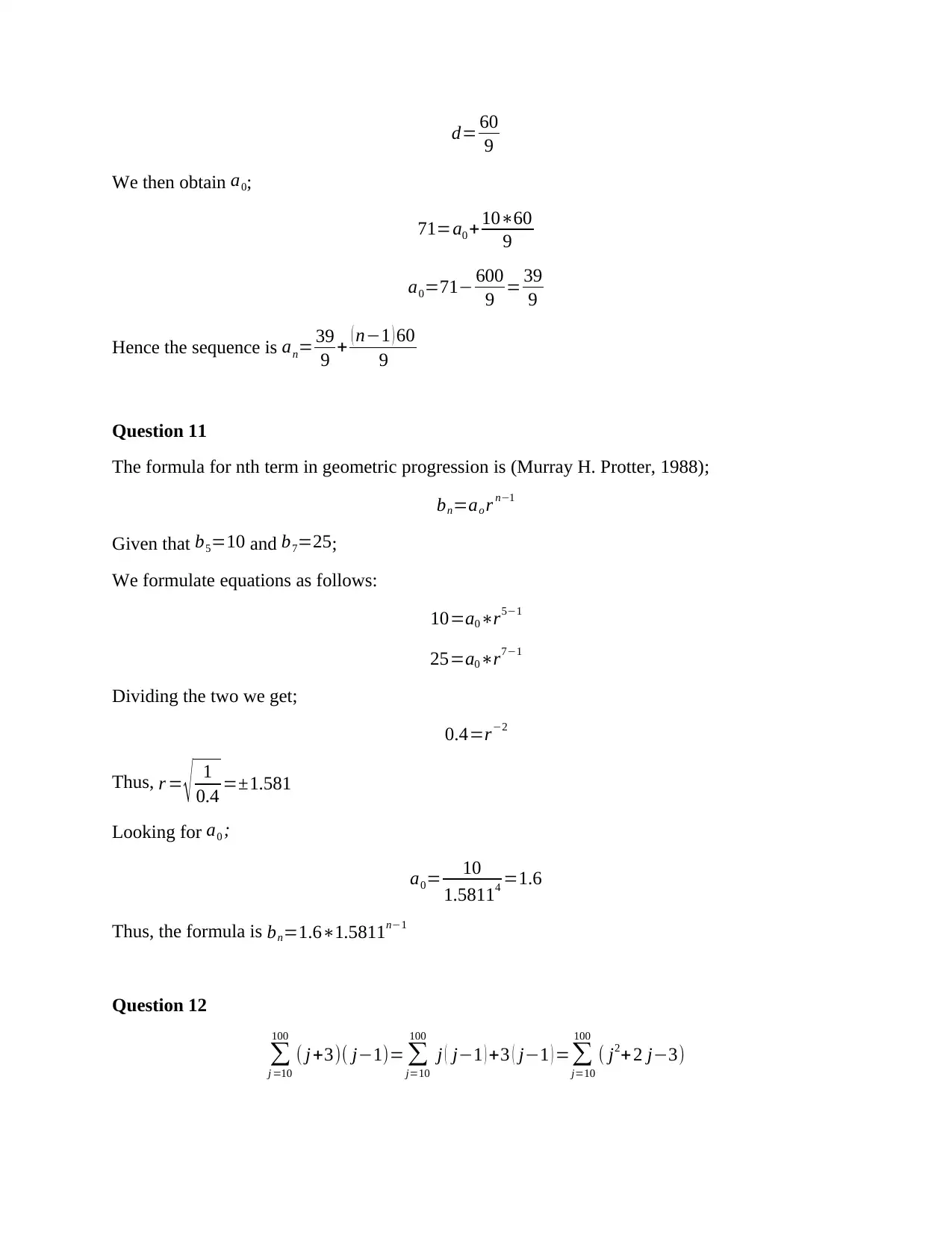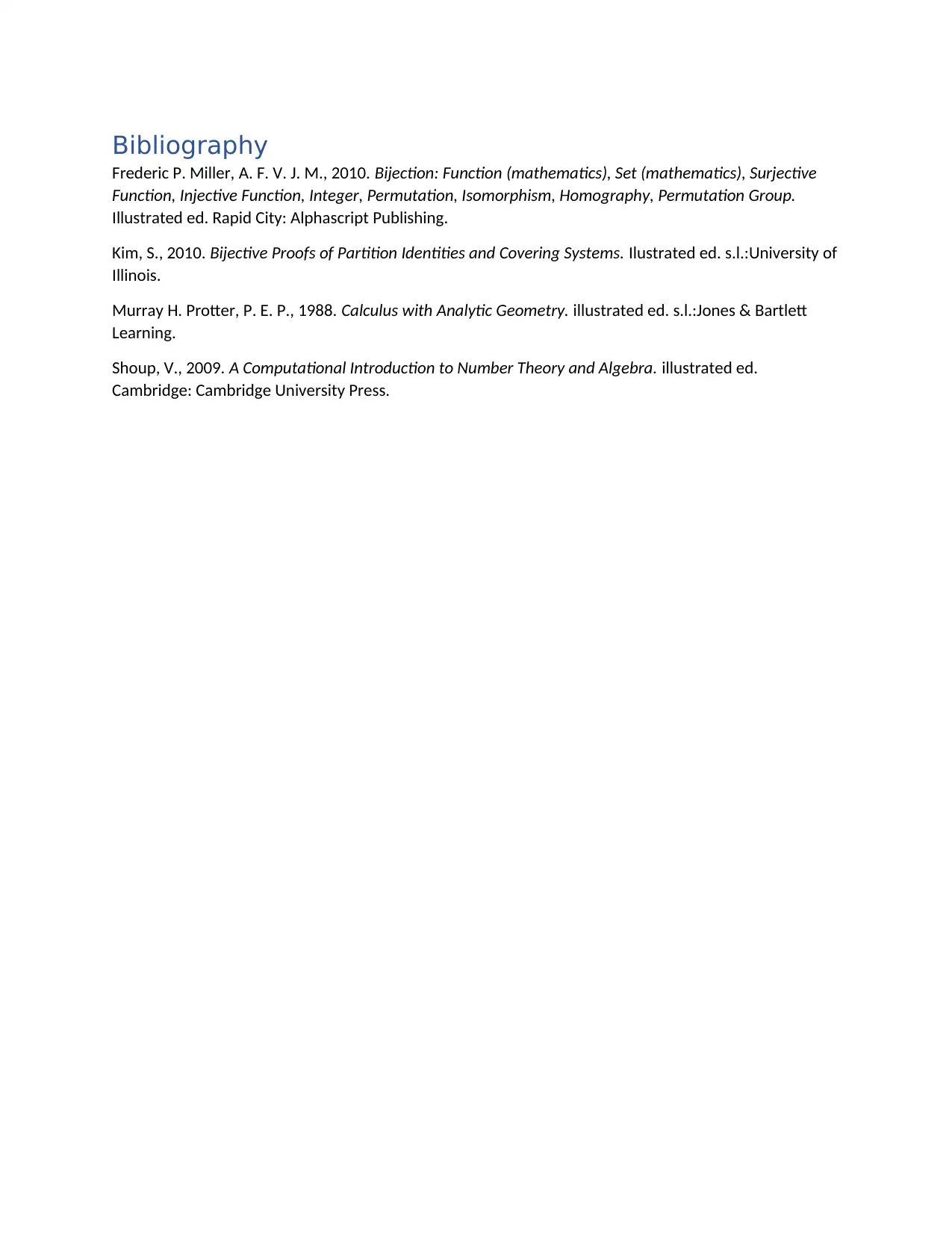MAT 243: Week 6 Homework Assignment on Functions and Proofs
VerifiedAdded on 2023/06/03
|9
|1357
|343
Homework Assignment
AI Summary
This document presents the solutions to a MAT 243 online written homework assignment. The assignment covers several key concepts in mathematics, including the equality of functions, proving and disproving bijectivity (injectivity and surjectivity) of functions, and working with the floor function. Specific problems involve determining if given functions are bijective, proving or disproving properties of the floor function, solving equations involving the floor function, and finding inverse functions. Furthermore, the assignment explores properties of trigonometric functions, and concludes with problems on arithmetic and geometric sequences, including finding specific terms and calculating sums.

Question 1
We check whether the domains and co-domains of f and g asbelow;
f : { 0 ,1 } → {0 ,1 } ; f ( x )=x2
When x=0 ,
f ( 0 ) =02=0
When x=1 ,
f ( 1 ) =12=1
Similarly,
g : { 0 , 1 } → { 0 , 1 } ; g ( x )=x
When x=0 ,
g ( 0 )=0
When x=1 ,
g ( 1 )=1
We check whether the domains and co-domains of f and g asbelow;
f : { 0 ,1 } → {0 ,1 } ; f ( x )=x2
When x=0 ,
f ( 0 ) =02=0
When x=1 ,
f ( 1 ) =12=1
Similarly,
g : { 0 , 1 } → { 0 , 1 } ; g ( x )=x
When x=0 ,
g ( 0 )=0
When x=1 ,
g ( 1 )=1
Paraphrase This Document
Need a fresh take? Get an instant paraphrase of this document with our AI Paraphraser

Therefore, they are equal functions in the given domain.
Question 2
To prove that a function if bijective, we prove that it is both injective and surjective (Frederic P.
Miller, 2010).
To prove that it is injective;
f ( x )=f ( y )
4 x+1=4 y+1
4 x=4 y
x= y
Question 2
To prove that a function if bijective, we prove that it is both injective and surjective (Frederic P.
Miller, 2010).
To prove that it is injective;
f ( x )=f ( y )
4 x+1=4 y+1
4 x=4 y
x= y

Thus, the function is injective.
To prove that it is surjective;
Taking x ∈ [ 0 ,1 ]∧ y ∈[0 , 1.5]
From the function y=4 x +1 ,
x= y−1
4
Using the range given for y and comparing with the range of values of x, we find that the
function is surjective.
Since the function is both injective and surjective, it is therefore bijective.
Question 3
Similar to question 2, we start by checking if the function is injective (Kim, 2010).
x , y ∈[−1, 1]
f ( x )=f ( y )
x2= y2
x= √ y2=± y
The function is not injective. Thus, the function is not bijective.
Question 4
First, we need to understand that ⌊ y ⌋ mean the closest integer less than y (Shoup, 2009).
Let’s take for instance x = 2.1 and y = 0.9;
⌊ x ⌋=2∧⌊ y ⌋=0
It means that
⌊ x ⌋ +⌊ y ⌋ =2+ 0=2
And
⌊ x+ y ⌋=⌊ 2.1+0.9 ⌋=3
Therefore, ⌊ x+ y ⌋ ≠ ⌊ x ⌋ +⌊[ y ] ⌋
To prove that it is surjective;
Taking x ∈ [ 0 ,1 ]∧ y ∈[0 , 1.5]
From the function y=4 x +1 ,
x= y−1
4
Using the range given for y and comparing with the range of values of x, we find that the
function is surjective.
Since the function is both injective and surjective, it is therefore bijective.
Question 3
Similar to question 2, we start by checking if the function is injective (Kim, 2010).
x , y ∈[−1, 1]
f ( x )=f ( y )
x2= y2
x= √ y2=± y
The function is not injective. Thus, the function is not bijective.
Question 4
First, we need to understand that ⌊ y ⌋ mean the closest integer less than y (Shoup, 2009).
Let’s take for instance x = 2.1 and y = 0.9;
⌊ x ⌋=2∧⌊ y ⌋=0
It means that
⌊ x ⌋ +⌊ y ⌋ =2+ 0=2
And
⌊ x+ y ⌋=⌊ 2.1+0.9 ⌋=3
Therefore, ⌊ x+ y ⌋ ≠ ⌊ x ⌋ +⌊[ y ] ⌋
⊘ This is a preview!⊘
Do you want full access?
Subscribe today to unlock all pages.

Trusted by 1+ million students worldwide

Question 5
First, we need to understand that if ⌊ x ⌋=n, then it follows that n ≤ ⌊ x ⌋ < n+1
We will have
5 ≤2 x−1<5+1
5+1 ≤2 x−1+1<6+1
6 ≤ 2 x <7
6
2 ≤ x<7
3 ≤ x < 7
2
Therefore, the interval is [ 3 , 7
2 )
Question 6
a) We need to note that the function is a bijection.
f−1 ( ( 0,1 ) )= ( cos−1 0 , cos−1 1 )
¿ (cos−1
(cos (−π
2 ) ), cos−1 ( cos 0 ) )∪¿
¿ ( −π
2 ,0 ) ∪ ( π
2 , 0 )
Rearranging;
¿ ( −π
2 ,0 ) ∪ ( 0 , π
2 )
b) f ( f −1 ( {−1 }) )=f ( cos−1−1 ) =f ( π )
It’s clear that π is out of range of the given domain [ −π
2 , π
2 ]. Therefore, the solution does
not exist.
c) f−1
(f ( { π
2 }) )=f−1
(cos ( π
2 ))=f −1(0)
¿ cos−1 ( 0 )
¿ π
2
d) Correct.
Taking X ⊆ (−π
2 ,0 ) ∪ X ⊆ (0 , π
2 )
First, we need to understand that if ⌊ x ⌋=n, then it follows that n ≤ ⌊ x ⌋ < n+1
We will have
5 ≤2 x−1<5+1
5+1 ≤2 x−1+1<6+1
6 ≤ 2 x <7
6
2 ≤ x<7
3 ≤ x < 7
2
Therefore, the interval is [ 3 , 7
2 )
Question 6
a) We need to note that the function is a bijection.
f−1 ( ( 0,1 ) )= ( cos−1 0 , cos−1 1 )
¿ (cos−1
(cos (−π
2 ) ), cos−1 ( cos 0 ) )∪¿
¿ ( −π
2 ,0 ) ∪ ( π
2 , 0 )
Rearranging;
¿ ( −π
2 ,0 ) ∪ ( 0 , π
2 )
b) f ( f −1 ( {−1 }) )=f ( cos−1−1 ) =f ( π )
It’s clear that π is out of range of the given domain [ −π
2 , π
2 ]. Therefore, the solution does
not exist.
c) f−1
(f ( { π
2 }) )=f−1
(cos ( π
2 ))=f −1(0)
¿ cos−1 ( 0 )
¿ π
2
d) Correct.
Taking X ⊆ (−π
2 ,0 ) ∪ X ⊆ (0 , π
2 )
Paraphrase This Document
Need a fresh take? Get an instant paraphrase of this document with our AI Paraphraser

f −1 ( f ( X ) ) =f −1 ( cos X )
¿ cos−1 (cos X )= X
Question 7
We start by checking if the function is injective.
f ( x )=f ( y )
x2+1= y2 +1
x2= y2
x= y
The function is injective.
To complete the bijective proof, we check whether the function is surjective.
y=x2 +1
x= √ y−1
Substituting in the function;
f ( √ y −1 ) = ( √ y−1 ) 2 +1= y
The function is surjective.
Hence, the function is bijective.
x= √ y−1
f−1 ( y )= √ y−1
f−1 ( x )= √x−1
Domain; [ 1 , ∞ )
Range; ¿
Question 8
We start by checking if it is injective.
f ( n )=f ( y )
⌊ √n ⌋ =⌊ √ y ⌋
⌊ n ⌋ ≠ ⌊ y ⌋
¿ cos−1 (cos X )= X
Question 7
We start by checking if the function is injective.
f ( x )=f ( y )
x2+1= y2 +1
x2= y2
x= y
The function is injective.
To complete the bijective proof, we check whether the function is surjective.
y=x2 +1
x= √ y−1
Substituting in the function;
f ( √ y −1 ) = ( √ y−1 ) 2 +1= y
The function is surjective.
Hence, the function is bijective.
x= √ y−1
f−1 ( y )= √ y−1
f−1 ( x )= √x−1
Domain; [ 1 , ∞ )
Range; ¿
Question 8
We start by checking if it is injective.
f ( n )=f ( y )
⌊ √n ⌋ =⌊ √ y ⌋
⌊ n ⌋ ≠ ⌊ y ⌋

Thus, the function is not injective. Hence, the function is not bijective.
Question 9
For maxima, dy
dx = 0∧d2 y
d x2 <0
dy
dx =4 x3 +4=0 ;
4 x3 =−4
x=−1
This is the only real solution.
d2 y
d x2 =12 x2
Inserting x=−1 ,
d2 y
d x2 =12 ( −1 ) 2=12>0
Meaning that we have minima. Therefore it tends to ∞ .
Replacing the value of x into the function;
f (−1 )= (−1 )4 + 4 (−1 ) +1=−2
Hence we need adjust the co-domain to ¿
Question 10
The general formula for arithmetic sequence is;
an=a0+ ( n−1 ) d
Given a11=71 and a20=131, we will formulate two linear equations as below.
71=a0 + ( 11−1 ) d
131=a0 + ( 20−1 ) d
Subtracting the two we obtain;
−60=−9 d
Question 9
For maxima, dy
dx = 0∧d2 y
d x2 <0
dy
dx =4 x3 +4=0 ;
4 x3 =−4
x=−1
This is the only real solution.
d2 y
d x2 =12 x2
Inserting x=−1 ,
d2 y
d x2 =12 ( −1 ) 2=12>0
Meaning that we have minima. Therefore it tends to ∞ .
Replacing the value of x into the function;
f (−1 )= (−1 )4 + 4 (−1 ) +1=−2
Hence we need adjust the co-domain to ¿
Question 10
The general formula for arithmetic sequence is;
an=a0+ ( n−1 ) d
Given a11=71 and a20=131, we will formulate two linear equations as below.
71=a0 + ( 11−1 ) d
131=a0 + ( 20−1 ) d
Subtracting the two we obtain;
−60=−9 d
⊘ This is a preview!⊘
Do you want full access?
Subscribe today to unlock all pages.

Trusted by 1+ million students worldwide

d= 60
9
We then obtain a0;
71=a0 + 10∗60
9
a0=71− 600
9 = 39
9
Hence the sequence is an= 39
9 + ( n−1 ) 60
9
Question 11
The formula for nth term in geometric progression is (Murray H. Protter, 1988);
bn=ao r n−1
Given that b5=10 and b7=25;
We formulate equations as follows:
10=a0∗r5−1
25=a0∗r7−1
Dividing the two we get;
0.4=r−2
Thus, r = √ 1
0.4 =±1.581
Looking for a0 ;
a0= 10
1.58114 =1.6
Thus, the formula is bn=1.6∗1.5811n−1
Question 12
∑
j =10
100
( j+3)( j−1)= ∑
j=10
100
j ( j−1 ) +3 ( j−1 ) =∑
j=10
100
( j2+2 j−3)
9
We then obtain a0;
71=a0 + 10∗60
9
a0=71− 600
9 = 39
9
Hence the sequence is an= 39
9 + ( n−1 ) 60
9
Question 11
The formula for nth term in geometric progression is (Murray H. Protter, 1988);
bn=ao r n−1
Given that b5=10 and b7=25;
We formulate equations as follows:
10=a0∗r5−1
25=a0∗r7−1
Dividing the two we get;
0.4=r−2
Thus, r = √ 1
0.4 =±1.581
Looking for a0 ;
a0= 10
1.58114 =1.6
Thus, the formula is bn=1.6∗1.5811n−1
Question 12
∑
j =10
100
( j+3)( j−1)= ∑
j=10
100
j ( j−1 ) +3 ( j−1 ) =∑
j=10
100
( j2+2 j−3)
Paraphrase This Document
Need a fresh take? Get an instant paraphrase of this document with our AI Paraphraser

¿ ∑
j=1
100
( j2 +2 j−3)−∑
j=1
9
( j2 +2 j−3)
¿ [ (100∗101∗201
6 )+ 2 (100∗101
2 )−3 (100 ) ]− [ ( 9∗10∗19
6 )+2 ( 9∗10
2 )−9∗3 ]
¿ 347802
Question 13
∑
n=10
800
43 n+1
52 n−1 = ∑
n=10
800
43 n∗5∗4
52n =20 ∑
n=10
800
( 43
52 )
n
¿ 20 ∑
n=10
800
2.56n
¿ 20 [ 2.5610 +2.5611+… … … … … ..+2.56800 ]
¿ 20∗2.5610 [ 1+2.56+ … … … … … … … … … ..+2.56790 ]
¿ 20∗2.5610∗[ 2.56790−1 ]
2.56−1
¿ 20∗2.5610
[ 2.56790−1
1.56 ]
j=1
100
( j2 +2 j−3)−∑
j=1
9
( j2 +2 j−3)
¿ [ (100∗101∗201
6 )+ 2 (100∗101
2 )−3 (100 ) ]− [ ( 9∗10∗19
6 )+2 ( 9∗10
2 )−9∗3 ]
¿ 347802
Question 13
∑
n=10
800
43 n+1
52 n−1 = ∑
n=10
800
43 n∗5∗4
52n =20 ∑
n=10
800
( 43
52 )
n
¿ 20 ∑
n=10
800
2.56n
¿ 20 [ 2.5610 +2.5611+… … … … … ..+2.56800 ]
¿ 20∗2.5610 [ 1+2.56+ … … … … … … … … … ..+2.56790 ]
¿ 20∗2.5610∗[ 2.56790−1 ]
2.56−1
¿ 20∗2.5610
[ 2.56790−1
1.56 ]

Bibliography
Frederic P. Miller, A. F. V. J. M., 2010. Bijection: Function (mathematics), Set (mathematics), Surjective
Function, Injective Function, Integer, Permutation, Isomorphism, Homography, Permutation Group.
Illustrated ed. Rapid City: Alphascript Publishing.
Kim, S., 2010. Bijective Proofs of Partition Identities and Covering Systems. Ilustrated ed. s.l.:University of
Illinois.
Murray H. Protter, P. E. P., 1988. Calculus with Analytic Geometry. illustrated ed. s.l.:Jones & Bartlett
Learning.
Shoup, V., 2009. A Computational Introduction to Number Theory and Algebra. illustrated ed.
Cambridge: Cambridge University Press.
Frederic P. Miller, A. F. V. J. M., 2010. Bijection: Function (mathematics), Set (mathematics), Surjective
Function, Injective Function, Integer, Permutation, Isomorphism, Homography, Permutation Group.
Illustrated ed. Rapid City: Alphascript Publishing.
Kim, S., 2010. Bijective Proofs of Partition Identities and Covering Systems. Ilustrated ed. s.l.:University of
Illinois.
Murray H. Protter, P. E. P., 1988. Calculus with Analytic Geometry. illustrated ed. s.l.:Jones & Bartlett
Learning.
Shoup, V., 2009. A Computational Introduction to Number Theory and Algebra. illustrated ed.
Cambridge: Cambridge University Press.
⊘ This is a preview!⊘
Do you want full access?
Subscribe today to unlock all pages.

Trusted by 1+ million students worldwide
1 out of 9
Related Documents
Your All-in-One AI-Powered Toolkit for Academic Success.
+13062052269
info@desklib.com
Available 24*7 on WhatsApp / Email
![[object Object]](/_next/static/media/star-bottom.7253800d.svg)
Unlock your academic potential
Copyright © 2020–2025 A2Z Services. All Rights Reserved. Developed and managed by ZUCOL.





![MATH130: Algebra Assignment 2 Solution - [University Name] - May 2019](/_next/image/?url=https%3A%2F%2Fdesklib.com%2Fmedia%2Fimages%2Fmf%2Ff5e9dd638f934d7d8421c8edf334793d.jpg&w=256&q=75)